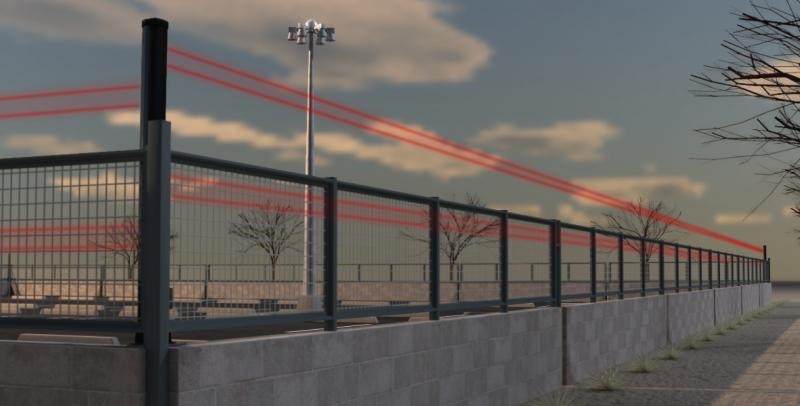High risk sites, such as critical infrastructure, government facilities, and high value industrial complexes, require robust security measures to prevent unauthorised access and potential threats. Among the many solutions available, perimeter detection and fencing systems are among the most effective first lines of defence.
At Rockfort Security Consultants, we advocate for these systems as essential components of a comprehensive security strategy. In this blog, we explore the advantages of installing perimeter detection and fencing around high-risk sites and how they can enhance your site’s security posture.
What Are Perimeter Detection and Fencing Systems?
Perimeter detection and fencing systems are security solutions designed to detect, deter, and delay unauthorised access to a secured site. These systems often include:
– Physical Barriers: Fences, walls, or gates that establish a clear boundary and restrict physical access.
– Detection Technologies: Sensors, cameras, and alarms integrated into the perimeter to detect breaches or suspicious activities.
– Access Control Points: Gates and checkpoints equipped with monitoring and authentication tools to control entry and exit.
These elements work together to provide layered protection, ensuring that threats are identified and addressed before they escalate.
Advantages of Perimeter Detection and Fencing
1. Deterrence of Potential Threats
A well designed perimeter acts as a strong deterrent to unauthorised individuals or groups. Features such as:
– High, sturdy fencing with anti-climb measures.
– Visible warning signs indicating surveillance and restricted access.
– Active security patrols and cameras integrated into the fencing.
These measures discourage intruders, reducing the likelihood of attempted breaches.
2. Early Threat Detection
Perimeter detection systems provide real-time monitoring of the boundary, enabling rapid identification of potential threats. Advanced technologies include:
– Motion Sensors: Detect movement near or on the fence.
– Vibration Sensors: Identify tampering or cutting attempts.
– Thermal and Infrared Cameras: Monitor activity in low visibility conditions.
By detecting threats early, security teams can respond swiftly, minimising the risk of escalation.
3. Enhanced Physical Security
Physical barriers slow down intruders, providing valuable time for response. Features such as:
– Reinforced fences with anti-cut and anti-ram capabilities.
– Gates with controlled access systems to ensure only authorised personnel enter.
These barriers not only delay unauthorised access but also channel movement towards monitored checkpoints, reducing vulnerabilities.
4. Integration with Advanced Security Systems
Modern perimeter solutions are designed to integrate seamlessly with other security systems, including:
– Surveillance Cameras: Providing visual confirmation of detected activities.
– Alarm Systems: Triggering alerts in the event of a breach.
– Access Control Systems: Ensuring that only verified individuals gain entry.
This integration enhances situational awareness, enabling a coordinated and efficient security response.
5. Customisation for Specific Needs
Perimeter detection and fencing solutions can be tailored to meet the unique requirements of high-risk sites, such as:
– Sensitive Facilities: Using discrete fencing that blends into the environment while maintaining security.
– Remote Locations: Deploying solar-powered systems to ensure functionality without reliance on local infrastructure.
– High-Traffic Areas: Designing access points that balance security with operational efficiency.
Customisation ensures that security measures are both effective and practical.
6. Regulatory Compliance and Risk Mitigation
For high-risk sites, compliance with industry regulations and standards is critical. Perimeter security measures help meet these requirements by:
– Ensuring restricted areas are clearly marked and protected.
– Providing audit trails through integrated monitoring and reporting systems.
– Reducing liability risks by demonstrating a commitment to safety and security.
7. Cost-Effective Long-Term Security
While the initial investment in perimeter detection and fencing may be significant, these systems offer long-term cost benefits by:
– Reducing the need for constant human patrols.
– Minimising losses due to theft, vandalism, or sabotage.
– Enhancing operational efficiency by streamlining access control processes.
These savings make perimeter security an invaluable investment for high-risk sites.
How Rockfort Security Consultants Can Help
At Rockfort Security Consultants, we specialise in designing and implementing perimeter security solutions tailored to your site’s unique challenges. Our services include:
– Risk Assessments: Identifying vulnerabilities and recommending appropriate security measures.
– System Design and Integration: Combining physical barriers with advanced detection technologies for comprehensive protection.
– Installation and Maintenance: Ensuring systems are deployed effectively and remain operational.
– Training and Support: Educating your team on best practices for monitoring and managing perimeter security.
For high-risk sites, perimeter detection and fencing systems are essential tools for mitigating threats and safeguarding operations. By deterring intruders, detecting breaches, and integrating with advanced security systems, these solutions provide the robust protection needed in today’s risk environment.
Contact Rockfort Security Consultants today to learn how we can help you design and implement a perimeter security strategy that ensures peace of mind and operational continuity.

